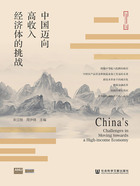
四 本书结构
在上述背景下,本书探讨了中国经济在向高收入经济体转型过程中面临的一系列挑战,其中包括农业发展、金融改革、人民币国际化、城镇化以及与创新、企业部门发展和市场竞争等相关的话题。中国的增长经验充满了令人振奋的变化和有关改革与结构变化的重要经验教训,因此今年的“中国经济前沿”再一次成为深入了解这些变化的途径。
在第二章,蔡昉和贾朋详细阐述了中国作为中等偏上收入国家的状况与国内社会流动趋势之间的关系,这些问题与中国克服中等收入陷阱的能力相关。作者利用跨国数据详细调查了发展阶段、增长率和社会不平等之间的关系,考察了在过去40多年的改革中中国经济增长的驱动因素,详细说明了这些驱动因素如何随时间变化。他们发现,过去几十年维持社会流动的主要驱动因素——劳动力市场机制、大规模国内移民和重大的结构性经济改革,随着中国的发展变得不再有效,而且即使是低增长的机会也逐渐减少。
对“只能通过做大经济蛋糕来解决社会流动性问题”这一观点,作者提出了质疑。他们认为这些问题必须通过经济和社会改革来解决,包括累进制税收、再分配政策,以及削弱体制性障碍尤其是户籍制度障碍。作者最后提出了旨在提高社会流动性和更公平地分享发展红利的政策建议。他们还建议对基本社会服务供给制度进行改革,使其按照实际的而非法律意义上的居住身份进行运作。同时,他们还强调中央政府降低户籍改革成本的体制性责任,以缓解地方政府在推行户籍制度改革时的相关外部性。
考虑到中国日益增长的农产品进口需求,第三章的作者饶思航、刘星铄和盛誉调查分析了中国当前和历史上17种主要农产品的比较优势和竞争优势。他们利用1978~2018年全球商品层面的农产品贸易数据,计算了比较优势指数(RCA)和竞争优势指数(RTA),从而比较中国在某些商品贸易中的比较优势。他们的研究发现,中国早期大多数农产品的相对优势与世界其他地区相比迅速下降,这表明人口和经济增长导致的需求增长速度超过了农业产出的增长速度。随着未来几十年中国粮食需求的进一步增长,作者预测了未来的大宗农产品需求并计算了中国和几个主要国家和地区之间的双边贸易互补系数,以确定潜在的最佳供应来源。他们的研究表明,进口土地和水资源密集型的产品从而腾出土地和资源来生产具有相对优势的产品符合中国的利益。
他们认为,虽然全世界有超过35亿公顷的土地适合耕种,但是只有约15亿公顷的土地得到了有效利用。如果中国和世界其他地区之间的贸易和投资关系能够根据其相对竞争力重新安排,那么全球粮食供应将大幅增加。因此,重新安排中国与其贸易伙伴之间的农产品贸易,可以为中国和世界提供双赢的结果。因此,担心中国的粮食需求将与其他发展中国家的需求相竞争从而给全球粮食供应带来更大压力的想法,可能是具有误导性的。
在第四章,王微、邓郁松、邵庭、王瑞民、牛三元和刘馨详细介绍了改革开放40多年来中国城市化取得的成就。作者描述了一个城市化水平稳步提高、城市格局不断优化、城市整体竞争力显著增强和城市治理体系不断完善的进程。伴随着这些进步的是居民生活水平的稳步提高。随着城镇化率达到60%,中国已经进入追求高质量发展的城市化新阶段——这一局面与新技术革命的发生同步出现。
展望2050年,作者预测中国将进入高收入国家行列,产业结构将发生深刻变革。随着城市产业的转型升级,未来城市将聚焦于高质量发展的需求。他们认为,中国需要不断提高城市化的质量和效率,从而创造一种高效、低碳和绿色的城市发展模式,新技术革命的创造和应用为中国城市的高质量发展提供了一个机遇。他们的研究表明,新一轮改革开放释放的巨大的国内市场潜力和制度红利,将成为中国下一阶段城市化的驱动力。
当前中国政府发现,必须要在降低税率以激励商业投资、促进消费与保持税收和财政支出匹配这两个目标之间进行必要的权衡。为了缓解这种紧张关系,第五章的作者徐琰超和陈晓光提出了一项税收中性的改革措施,其政策中心就是针对那些面临资源错配和生产率损失的企业,改善其税收执行情况。他们研究了持续推进这项改革的理论机制并实证研究了可行性,结果发现潜在机制是“更低的税率=更好的税收执行和合规性=更高的生产率=更大的税基=更低的利率”。基于2000~2007年的县级财政数据和工业企业调查数据,作者将2005年取消农业税作为一项准自然实验来检验关键机制。通过使用关键参数的估计量,作者初步测算了能够推进收入中性改革的增值税税率的下限。
在第六章,孙思忠探讨了中国的总体创新活动及其增长效应。通过对投入(包含研发)产出(包含专利数)的检验,作者得出了对理解中国经济增长潜力具有重要作用的几个结论:第一,中国的创新处于上升通道,几乎没有增长放缓的迹象;第二,长期来看,创新似乎可以促进国家和行业层面的经济增长;第三,国家层面的创新不具有短期增长效应。考虑到创新的增长效应和中国面临的日益紧张的资源约束,创新很可能会在中国未来的经济增长中发挥重要的作用。
对中国企业财务状况的分析为了解中国经济的发展轨迹提供了重要线索,有助于评估政府政策对商业和企业活动的影响。在第七章,乔尔·鲍曼(Joel Bowman)首先对中国企业部门经营状况进行分析,发现自全球金融危机爆发以来,中国的企业部门盈利能力普遍下降,企业杠杆率上升。作者试图通过对官方调查数据和来自上海证券交易所、深圳证券交易所3700多家上市非金融企业财务报表的颗粒数据,来提供关于行业发展的最新信息。作者发现,近期企业盈利能力的下降主要是由私人部门推动的,尽管民营企业的盈利水平仍然要高于国有企业。
这些研究结果表明,导致企业盈利能力下降的主要因素包括:旨在降低金融系统风险的改革导致的对监管不严的信贷的挤压,以及私人部门更容易受到全球制造业和贸易增长放缓的影响,出口导向型制造业企业尤其感受到了这一点,因为它们受到了发达经济体经济相对疲软和中美贸易摩擦的影响。在研究了企业杠杆率现状和房地产行业面临的特殊挑战后,作者详细介绍了政府部门最近旨在改善小企业财务状况的系列措施,同时也承认了在实践中实现这些目标的挑战。
在经济全球化和国内土地、劳动力低成本的背景下,加工贸易发展是中国经济增长、工业化和就业的重要动力。在第八章,李坤望和胡浩然考察了2003年开始实施的旨在促进加工贸易转型升级的系列政策的影响。作者基于2000~2006年的中国海关数据和工业面板数据,使用双重差分法实证检验了加工贸易转型升级政策对企业生产率的影响。
他们的研究表明,这些政策导致了资源错配,并对生产率产生了净的负面影响。由于这些政策明显促进了加工贸易从中国东部地区向西部和中部地区转移,这就使得具备自然地理和物流优势的东部地区受到最大的负面影响,扰乱了生产效率和原始资源配置状况。这些政策的目的是培育民营企业,作者发现从事进口原材料加工贸易的外资企业和合资企业尤其受到了政策挤出效应的负面影响,从而拖累了总体生产率。他们发现,自2000年以来,中国的加工贸易呈稳步下降的趋势,但产品结构有所改善。作者认为产业政策应该以效率为导向,从而避免产生新的扭曲。
在第九章,张礼卿、尹力博和吴优用一个扩展的敞口利率平价回归模型分析了双边离岸人民币的回报率,从而评估了离岸人民币的避险资产特征。为了探讨这一问题,作者评估了离岸人民币对全球主要货币和“一带一路”沿线国家的双边汇率回报及其与全球风险行为体之间的关系。他们的研究表明:第一,离岸人民币表现出避险特征,并存在于某些全球主要货币和部分“一带一路”沿线国家的货币中;第二,与全球主要货币相比,“一带一路”沿线国家货币表现出的离岸人民币避险特征相对较弱;第三,上述提到的特征表现出时变性,在极端情况下,离岸人民币的套期保值价值更为突出。相关结果为全球金融市场的资产配置、对冲策略安排乃至系统性风险的防范提供了重要参考。
参考文献
Bai,C. and Lei,X.(2020),New trends in population aging and challenges for China’s sustainable development,China Economic Journal 13(1):3-23.doi.org/10.1080/1753 8963.2019.1700608.
Cai,F.,Garnaut,R. and Song,L.(2018),40 years of China’s reform and development:How reform captured China’s demographic dividend,in R.Garnaut,L.Song and F.Cai(eds),China’s 40 Years of Reform and Development:1978-2018,5-28,Canberra:ANU Press.doi.org/10.22459/CYRD.07.2018.01.
Canning,D. and Bennathan,E.(2000),The social rate of return on infrastructure investments,The World Bank Policy Research Working Paper 2390,Washington,DC:The World Bank.doi.org/10.1596/1813-9450-2390.
Dollar,D.,Huang,Y. and Yao,Y.(eds)(2020),China 2049:Economic challenges of a rising global power,Washington,DC:Brookings Institution Press.
Drysdale,P. and Hardwick,S.(2018),China and the global trading system:Then and now,in L.Song,R.Garnaut and F.Cai(eds),China’s 40 Years of Reform and Development:1978-2018,545-74,Canberra:ANU Press.doi.org/10.22459/CYRD.07.2018.27.
Fraumeni,B.M.,He,J.,Li,H. and Liu,Q.(2019),Regional distribution and dynamics of human capital in China 1985-2014,Journal of Comparative Economics 47(4):853-66.doi.org/10.1016/j.jce.2019.06.003.
Guo,Y.,Zhou,Y. and Liu,Y.(2019),Targeted poverty alleviation and its practices in rural China:A case study of Fuping county,Hebei Province,Journal of Rural Studies. doi.org/10.1016/j.jrurstud.2019.01.007.
Heerink,N.,Kuiper,M. and Xiaoping,S.(2006),China’s new rural income support policy:Impacts on grain production and rural income inequality,China & World Economy 14(6):58-69.doi.org/10.1111/j.l749-124X.2006.00045.x.
International Monetary Fund(IMF)(2021),World Economic Outlook Update,January,Washington,DC:IMF. Available from:www.imf.org/en/Publications/WEO/Issues/2021/01/26/2021-world-economic-outlook-update.
Jiang,P.,Chen,Y.,Geng,Y.,Dong,W.,Xue,B.,Xu,B. and Li,W.(2013),Analysis of the co-benefits of climate change mitigation and air pollution reduction in China,Journal of Cleaner Production 58:130-37.doi.org/10.1016/j.jclepro.2013.07.042.
Kharas,H.(2017),The unprecedented expansion of the global middle class:An update,Global Economy & Development Working Paper 100,February,New Delhi:Brookings India. Available from:hdl.handle.net/11540/7251.
Kojima,K.(2000),The‘flying geese’model of Asian economic development:Origin,theoretical extensions,and regional policy implications,Journal of Asian Economics 11:375-410.doi.org/10.1016/S1049-0078(00)00067-1.
Li,H.,Li,L.,Wu,B. and Xiong,Y.(2012),The end of cheap Chinese labor,Journal of Economic Perspectives 26(4):57-74.doi.org/10.1257/jep.26.4.57.
Li,H.,Liu,Q.,Fraumeni,B. and Zhang,X.(2014),Human capital estimates in China:New panel data 1985-2010,China Economic Review 30(September):397-418.doi.org/10.1016/j.chieco.2014.07.006.
Lin,J.Y.(2013a),Demystifying the Chinese economy,The Australian Economic Review 46(3):259-68.doi.org/10.1111/j.l467-8462.2013.12035.x.
Lin,J.Y.(2013b),From flying geese to leading dragons:New opportunities and strategies for structural transformation in developing countries,in J.E.Stiglitz,J.Y.Lin and E.Patel(eds),The Industrial Policy Revolution Ⅱ,International Economic Association Series,50-70,London:Palgrave Macmillan.doi.org/10.1057/9781137335234_3.
Lipton,M.(2007),Urban bias revisited,The Journal of Development Studies 20(3):139-66.doi.org/10.1080/00220388408421910.
Liu,S.(2018),The structure of and changes to China’s land system,in R.Garnaut,L.Song and F.Cai(eds),China’s 40 Years of Reform and Development:1978-2018,427-54,Canberra:ANU Press.doi.org/10.22459/CYRD.07.2018.22.
McKay,H. and Song,L.(2010),China as a global manufacturing powerhouse:Strategic considerations and structural adjustment,China & World Economy 18(1)(February):1-32.doi.org/10.1111/j.l749-124X.2010.01178.x.
Meinhardt,C.(2020),China bets on‘new infrastructure’to pull the economy out of post-Covid doldrums,Short Analysis,4 June,Berlin:Mercator Institute for China Studies. Available from:merics.org/en/short-analysis/china-bets-new-infrastructure-pull-economy-out-post-covid-doldrums.
National Bureau of Statistics of China(NBS)(2021),2020 Statistical Communiqué of the People’s Republic of China on National Economic and Social Development,[in Chinese],28 February,Beijing:NBS.Available from:www.stats.gov.cn/tjsj/zxfb/202102/t20210227_1814154.html.
National Development and Reform Commission(NDRC)(2021),The Fourteenth Five-Year Plan for the National Economic and Social Development of the People’s Republic of China and the Outline of the Long-Term Goals for 2035,Beijing:NDRC. Available from:www.ndrc.gov.cn/xxgk/zcfb/ghwb/202103/t20210323_1270124.html.
Pugh,C.(1996),‘Urban bias’,the political economy of development and urban policies for developing countries,Urban Studies 33(7):1045-60.doi.org/10.1080/00420989650011492.
Qin,Y.(2016),China’s transport infrastructure investment:Past,present,and future,Asian Economic Policy Review 11(2):199-217.doi.org/10.1111/aepr.12135.
Roberts,I.,Saunders,T.,Spence,G. and Cassidy,N.(2016),China’s Evolving Demand for Commodities. Reserve Bank of Australia. Available from:www.rba.gov.au/publications/confs/2016/pdf/rba-conference-volume-2016-roberts-saunders-spence-cassidy.pdf.
Sheng,Y. and Song,L.(2019),Agricultural production and food consumption in China:A long-term projection,China Economic Review 53:15-29.doi.org/10.1016/j.chieco.2018.08.006.
Song,L. and van Geenhuizen,M.(2014),Port infrastructure investment and regional economic growth in China:Panel evidence in port regions and provinces,Transport Policy 36(November):173-83.doi.org/10.1016/j.tranpol.2014.08.003.
Song,L. and Zhou,Y.(2020),COVID-19 pandemic and its impact on the global economy:What does it take to turn crisis into opportunity?,China & World Economy 28(4):1-25.doi.org/10.1111/cwe.12349.
Thirlwall,A.P.(2011),Economics of Development,New York:Palgrave Macmillan.
Thirlwall,A.P.(2015),A plain man’s guide to Kaldor’s growth laws,in Essays on Keynesian and Kaldorian Economics,Palgrave Studies in the History of Economic Thought Series,326-38,London:Palgrave Macmillan.doi.org/10.1057/9781137409485_15.
United Nations Conference on Trade and Development(UNCTAD)(2021),World Investment Report,Geneva:UNCTAD. Available from:unctad.org/topic/investment/world-investment-report.
World Bank(2021),World bank country and lending groups,Data,Washington,DC:The World Bank. Available from:datahelpdesk.worldbank.org/knowledgebase/articles/906519-world-bank-country-and-lending-groups.
Xinhua(2021a),China’s industrial robot output up 19.1 pct in 2020,XinhuaNet,17 February. Available from:www.xinhuanet.com/english/2021-02/17/c_139747876.htm.
Xinhua(2021b),Huawei 5GtoB solution aims at 1,000 smart factories,XinhuaNet,9 May. Available from:www.xinhuanet.com/english/2021-05/09/c_139934818.htm.
Yu,N.,De Jong,M.,Storm,S. and Mi,J.(2012),The growth impact of transport infrastructure investment:A regional analysis for China(1978-2008),Policy and Society 31(1):25-38.doi.org/10.1016/j.polsoc.2012.01.004.
Yu,Y.(2018),A trade war that is unwarranted,China & World Economy 26(5):38-61.doi.org/10.1111/cwe.12255.
Zhao,Z.(2011),China’s demographic challenges from a global perspective,in J.Golley and L.Song(eds),Rising China:Global Challenges and Opportunities,285-300,Canberra:ANU Press.doi.org/10.22459/RC.06.2011.16.
Zheng,X.,Lu,Y.,Yuan,J.,Baninla,Y.,Zhang,S.,Stenseth,N.C.,Hessen,D.O.,Tian,H.,Obersteiner,M. and Chen,D.(2020),Drivers of change in China’s energy-related C02 emissions,Proceedings of the National Academy of Sciences 117(1):29-36.doi.org/10.1073/pnas.1908513117.
Zhou,W.,Gao,H. and Bai,X.(2019),Building a market economy through WTO-inspired reform of state-owned enterprises in China,International & Comparative Law Quarterly 68(4):977-1022.doi.org/10.1017/S002058931900037X.
Zhou,Y.(2014),Role of institutional quality in determining the R&D investment of Chinese firms,China & World Economy 22(4):60-82.doi.org/10.1111/j.1749-124X.2014.12075.x.
[1] 世界银行(2021)根据人均GDP将各经济体分为低收入、中低收入、中高收入和高收入经济体。